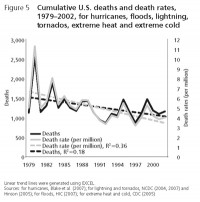By Indur Glokany
Reuters reports that: Heat is more likely to kill an American than an earthquake, and thunderstorms kill more people than hurricanes do, according to a U.S. “death map” published on Tuesday. Heat and drought caused 19.6 percent of total deaths from natural hazards, with summer thunderstorms causing 18.8 percent and winter weather causing 18.1 percent, the team at the University of South Carolina found. However, the result that heat is the most deadly natural hazard seems to be an artifact of the data source employed by the authors of the so-called “death map.” Their primary data source is the National Climatic Data Center’s Storm Data. However, the NCDC data for mortality from extreme heat and cold is questionable.
As is evident from the paper, the authors are aware that mortality data for these two types of extreme events from NCDC are substantially different from mortality data from the Center for Disease Control (CDC) based on the Compressed Mortality File for the United States. The latter uses death certificate records, which provide the cause of each recorded death (based on medical opinion). I would contend that when it comes to cause of death, particularly for extreme cold and heat, medical opinion as captured in death certificate records is probably more reliable than determinations made by the meteorologists in the National Oceanic and Atmospheric Administration’s NCDC.
The following table from Goklany (2007) provides a breakdown of mortality due to the major types of extreme weather events for 1979-2002 based on data from the CDC database for extreme cold and extreme heat, and various arms of the National Oceanic and Atmospheric Administration for floods, lightning, hurricanes, and tornadoes. It indicates that extreme cold, rather than heat, is the deadliest form of extreme weather event. In fact, over this period, extreme cold was responsible for slightly more than 50 percent of deaths during this period for the categories listed in the table.

See large table here
Note that despite the hoopla about natural weather disasters, they contribute less than 0.06% to the annual U.S. death toll! Moreover, as the following figure, also from Goklany (2007), shows, both US death and death rates from weather events are declining, despite any climate change, which we are assured can only make matters worse.

See larger graph here
Finally, the Reuters report notes, “Researchers who compiled the county-by-county look at what natural disasters kill Americans said they hope their study will help emergency preparedness officials plan better.” [The study was apparently funded by the Department of Homeland Security.] As a taxpayer, I hope that emergency preparedness officials look beyond this study to identify and prepare for future emergencies, or they might miss out on the larger disasters, even as they prepare for lesser ones. Read full post here.
NOAA NCDC continues to degrade their credibility. Not only are they cooking the books on temperature adjustments but are doing it on mortality statistics to make heat look more of a threat. Soon I would expect them to start denying the existence of the dust bowl and 1930 heat records which to this day dominate the record books.


